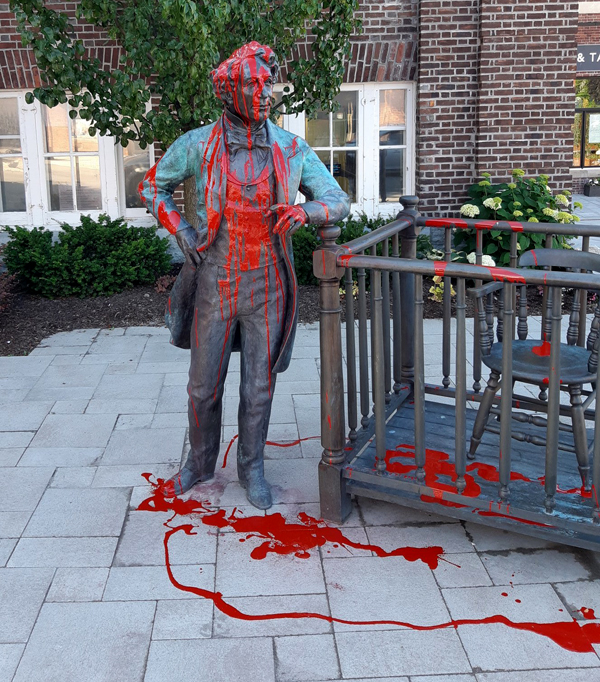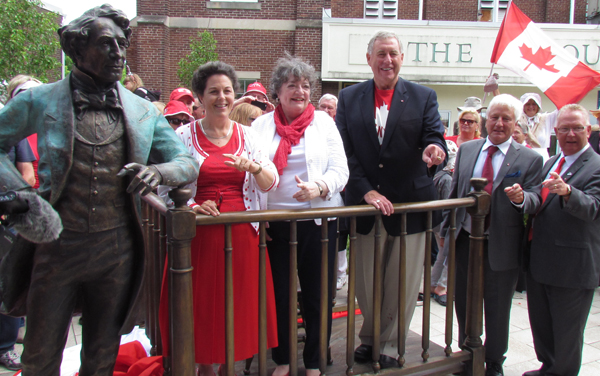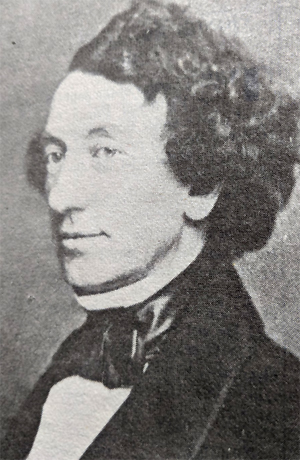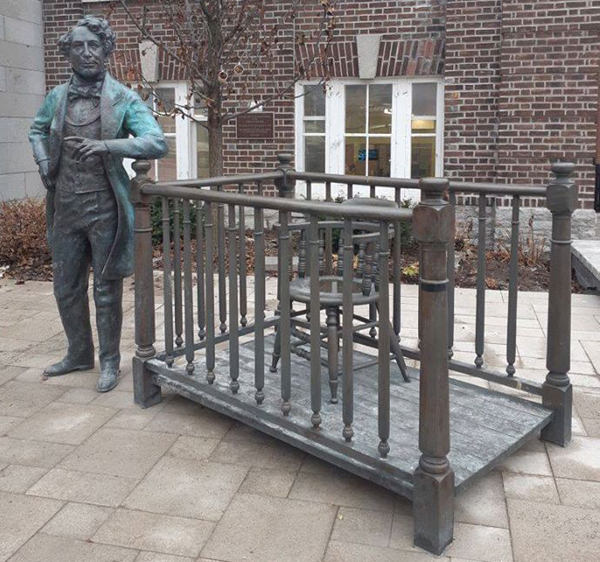Will verdict ‘You’ll never die, Sir John!’ crumble in 2020?
Administrator | Sep 08, 2020 | Comments 20

By Sue Capon
As tension continues over statues of Canada’s first prime minister – toppled, decapitated, vandalized, and moved into storage – citizens across the nation are protesting and supporting the legacy of a man – with roots in Prince Edward County – who is credited with both building the nation, and of mistreatment of Indigenous peoples.
Debates on Sir John A. Macdonald’s contributions to history reignited in Picton early this summer following two instances of mischief where his bronze statue was splashed with red paint.

Picton’s bronze portrait of Canada’s first prime minister was unveiled July 1, 2015 to commemorate the 200th anniversary of his birth. The creation by artist Ruth Abernethy depicts the 19-year-old Macdonald presenting his first case to a judge and jury in Oct. 8, 1834 in the new courthouse in Picton. He won that trial as a student of law, and a few months later passed his Attorney Examination at the Law Society of Upper Canada. That marked the beginning of a 56-year career in law and politics.

From Alan R. Capon’s book Prince Edward County Treasury, John A. Macdonald c 1856. Public Archives Canada photo
As Alan R. Capon wrote in his book “Prince Edward County Treasury”, Macdonald was no stranger to Prince Edward County.
“His father Hugh, and mother Helen, operated a grist mill at Stone Mills (Glenora) after previous business ventures in Kingston and Hay Bay had failed. John was about 10 when he moved to Stone Mills. During his stay in Hallowell, Macdonald became the first secretary of the Hallowell Young Men’s Society, and the Prince Edward District School Board appointed him secretary.”
The spirit of Sir John A Macdonald continued to live on in Prince Edward County to this day, Capon wrote. “And many in the area agree with the nameless supporter who cried out at one of Macdonald’s political meetings, “You’ll never die, Sir John!”
That verdict of history may change in December, 2020 – already an unprecented year of change due to the COVID-19 pandemic.
Picton’s Macdonald sculpture was in storage for several months last year while landscaping took place in front of The Armoury and was re-located on the forecourt at the Picton Library, a short distance east of its former location.
That was the catalyst for conversation to remove the statue.
In November 2019 the Picton Library hosted a full-house presentation by Dr. Niigaan Sinclair on Macdonald’s abuse of Indigenous peoples in the Canada. His father, Justice Murry Sinclair, was the chair of the Truth and Reconciliation Commission of Canada.
Citizens woke to the knowledge of Indigenous history demanded action.
County council has since formed the “Holding Court” Statue Working Group under the Prince Edward Heritage Advisory Committee (PEHAC), to conduct public consultation, research and ultimately to make recommendation about the statue’s future, following the scope of the 10 Principles of Truth and Reconciliation, a framework put forth by the federal Truth and Reconciliation Commission, to move forward establishing and maintaining respectful relationships.
 Retired university professor David Warrick, who was the chair of the Macdonald Project group that commissioned the 1,400-pound statue for Picton, is a member of the new working group.
Retired university professor David Warrick, who was the chair of the Macdonald Project group that commissioned the 1,400-pound statue for Picton, is a member of the new working group.
His deep concern is a condition by the group to exclude discussion and debate of Canadian history and Macdonald’s achievements.
“You can’t defend Macdonald without historical context,” said Warrick, who addressed accusations against Sir John and his historical achievements, as a guest speaker at a Picton Rotary Club meeting last week.
“The first thing students of history are taught is the importance of cause of events and the context of events,” said Warrick. “A cause is something that brings an effect, for instance, the killing of George Floyd. The context, is understood as the climate of opinion, that surround the issue at hand. They help to understand its urgency, its importance, its shape or even its timing. That would be Black Lives Matter.
“As we look at the history of Macdonald, we need to look at events farther afield such as the Slaughter of the Buffalo in the U.S. and the American Civil War, to understand the choices Macdonald faced as he led the nation as Prime Minister.”
Warrick says Macdonald’s legacy should be commemorated as a nation builder and as such, his bronze portrait of his time in Prince Edward County should remain on Main Street Picton.
“Without Macdonald, there would be no Canada,” said Warrick. “Unlike most nation states, Canada was not created by revolution, nor conquest. It was created through extensive negotiations and much compromise… Macdonald devoted his entire life to Canada (Premier of Canada for six years, Prime Minister for 19 years) and died in office at the age of 76.”
Warrick’s presentation to Rotarians noted Macdonald’s negotiated purchase of Rupert’s Land, from the Hudson’s Bay Company for $1.5 million in 1869 – among at least nine attempts to annex Canada.
 “In spite of strong competition from the U.S. which was willing to pay much more after purchasing Alaska from Russia for $7.2 million. There would be no Canada without this purchase. The U.S. would be the largest country in the world today.”
“In spite of strong competition from the U.S. which was willing to pay much more after purchasing Alaska from Russia for $7.2 million. There would be no Canada without this purchase. The U.S. would be the largest country in the world today.”
The sale involved roughly a quarter of the continent, but failed to take into account existing residents – mainly Indians and Metis. But Warrick noted the U.S. treatment of its Indigenous citizens was even more horrific.
Warrick said that by 1871 U.S. President Ulysses S. Grant initiated the Buffalo Policy: “A buffalo dead is an Indian gone” further to the U.S. Indian Removal Act. 30 million Bison were slaughtered in North America and replaced with Texas Longhorn to force Indians onto reservations, mainly in Oklahoma.
Grant ended hundreds of Indian treaties. Prime Minister Macdonald began the first of 11, covering most of Canada today.
“It was seen as a way to starve Native Americans into submission,” said Warrick. “The Canadian government began a program to settle Indians on reserves so they would not interfere with the spread of agricultural settlement across the prairies. The Indian, bedeviled by alcoholism, smallpox epidemics, disappearance of the bison, and subsequent famine, had no alternative but to accept that program.”
Warrick told Rotarians the charges against keeping Picton’s Macdonald statue, gathered from a recent online petition, state he was the primary perpetrator of genocide in Canada; created the residential school system, and his statue ‘makes people feel unsafe and uncomfortable’ as well “It is embarrassing to see Macdonald, and the colonial violence that he has come to symbolize, honoured in bronze on Main Street.”
Sir John, stated Warrick, immediately implemented the largest relief program in Canadian history (until the Great Depression) and received more than a little criticism over the cost and scope, but without a doubt saved thousands of native lives,” said Warrick. “He was criticized for being too generous because the federal government was not, at the time, in the business of providing relief programs. The spending amounted to more than three per cent of the federal budget – $6-$8 billion in today’s dollars.”
“In parliament in 1885, Macdonald was criticized for the continuing expense in providing land, agricultural tools, education and general education for natives and the slow progress in moving Natives from a hunter gatherer society into the modern world. His government also carried out a program to vaccinate all Native Canadians against smallpox – 4,000 died of it in Montreal in 1884 and more so for Native Canadians.”
Regarding the implementation of Indigenous schools, Warrick reminds “the first Industrial School was created in Brantford in 1828 called the Mohawk Institute – when Macdonald was 13, and in a grammar school.
“The Anglican Chruch ran the school with aid from the U.S. When it became a residential school in 1834, Macdonald was 19 and studying for his law exams in Picton.”
“In contrast to compulsory public schools, the schools for Native Canadians were voluntary under Macdonald’s term in office, despite pressure from government to make them mandatory. However, Prime Minister John Thompson made the schools compulsory three years after Macdonald’s death in 1891. The schools were administered by the churches: Catholic churches 60 per cent and the Anglican church 30 per cent, and the rest Protestant.”
“Macdonald did not start the residential schools that are so heavily criticized today.”
Warrick’s also compared Mohawk Chief Joseph Brant (Thayendanegea)’s view on law and order with Macdonald’s.
“In the government you call civilized, the happiness of the people is constantly sacrificed to the splendor of empire, hence the origin of your codes of criminal and civil laws; hence your dungeons and prisons. We have no prisons; we have no pompous parade of courts; we have no written laws; and yet judges as highly revered among us as they are among you, and their decisions are as much regarded.”
Warrick quotes Macdonald’s view from a speech to the House of Commons in 1890:
“Whether is was conquered or ceded, we have a constitution now under which all British subjects are in a position of absolute equality, having equal rights of every kind – of language, of religion, of property and of person. There is no paramount race in this country; there is no conquered race in this country; we are all British subjects, and those who are not English are none the less British subjects on that account.”
Warrick adds Macdonald drafted 50 of the 72 resolutions that were founding principles of the Constitution Act of 1867.
Capon, in his book Prince Edward County Treasury, also captured opposing views of Picton’s two newspapers, following Macdonald’s death.
The Picton Times editor’s comment on Friday, June 12, 1891, following the death of Canada’s first prime minister noted: “He had lived much beyond the allotted three score and ten. He had taken advantage of and, at times had made opportunities without scruple in order to success in the line of life which he had chosen.”
Capon notes the editor commented on the tendency at that time “to gush” over the late prime minister, noting the injuction to not speak ill of the dead.
“The writer said that the career of a public man was, however public property and history had to be recorded truthfully.”
Capon noted the article said Macdonald was “pre-eminently a political pirate” and added “he was but little of the statesman; the longer he lived he became less entitled to high distinction in that line…”
Capon also recorded that the long editorial commented on Macdonald’s “shameful transactions” in the Pacific scandal and said his “so-called national policy was one of the most imprudent frauds ever perpetuated upon a gullible people.
“We have lightly touched upon a few of the sinister features in Sir John Macdonald’s record. It is not to be inferred that we would put that record forward as one of unqualified badness.”
The editor of The Picton Gazette, Capon noted, was appalled at his contemporary at the Times.
“In a rebuttal headed ‘The ghouls at work” the editor wrote: ‘It is the custom among savage and depraved races, that seem to be destitute of the moral sense, to sneak back to the field where some great battle has been fought and some mighty chieftan had fallen, and mutilate the dead. Last Thursday, June 11, when the earth clods were falling on the coffin of Sir John Alexander Macdonald – when sad hearts felt as if stunned by the national calamity that had befallen them – the newsboy was delivering to the subscribers of The Picton Times its last diatribe against the illustrious dead, the wail of a disappointed man.”
Despite the fulminations of The Times, the spirit of Sir John lived on in Prince Edward County to this day.
Will the verdict ‘You’ll never die, Sir John!’ crumble in 2020?
By December, the working group mandate is to advise county staff in preparation of a report to the Heritage Advisory Committee, which will make its recommendation to council.
The working group is currently receiving comments on the municipality’s website ‘Have Your Say’ public engagement page.
To submit comments, the public can also do so through deputations, at the town hall to be held this fall; by sending an email to ecowan@pecounty.on.ca or by mail to The Holding Court Statue Working Group, c/o County of Prince Edward, 332 Main St., Picton, ON K0K 2T0.
Filed Under: Arts & Culture • Featured Articles
About the Author:
































For some people works of art are neither dismissible nor dispensable. When the Taliban blew up thousand-year-old giant statues of the Buddha, there was wide outrage, even among those who weren’t Buddhists. When ISIS destroyed three-thousand-year-old Babylonian artifacts and threatened the well-preserved ruins of ancient Palmyra, there was again an outcry around the world.
Perhaps the Macdonald statue is too new to have earned broad respect. But that is exactly my main argument: Works of art can transcend time and are difficult to judge in the midst of controversy. When we erase “only a work of art,” we destroy, not history, but a cultural legacy.
My 2nd choice would be to place McDonald on the Shire Hall property in the Parkette. It’s Main street and his law office was right next door. Still not as secure as an inside but you say security lights will work so have at it.
We should never succumb to criminal vandals or cancel culture attempts to silence Canadians who hold pride in our Country while recognizing our failings. We learn, we grow, we change.
Given the current situation with COVID-19 and other serious issues do we have nothing better to do than to continue to argue among ourselves and vilify Macdonald for his misdeeds of more than a century ago? Who is equipped to pass judgement? Should we investigate and judge the judges? There could be something in their past that has been whitewashed.The court house initially was considered as the location for the statue but the idea was rejected because it was agreed that Main Street was a better choice because the statue would be more readily seen. It should remain where it is with security cameras in place. Bowing to vandals simply gives them encouragement. No one voiced strong disapproval either of the statue or its location when it was first proposed. The ship has sailed and other than encouraging the public to learn all about Sir John warts and all it’s time to move on to things we can change for the better.
The Toronto Star reported:
“The online poll by Leger and the Association for Canadian Studies follows the controversial tearing down and vandalism of a Macdonald statue in Montreal last month by activists angry over his anti-Indigenous views and policies.
Half of respondents to the survey said they oppose the idea of removing statues or monuments to politicians who espoused racist views or implemented racist policies, while 31 per cent said they support such moves and 19 per cent did not know.
Yet 75 per cent of respondents to the poll were against the Montreal-style “spontaneous” tearing down of Macdonald statues by activists while only 11 per cent said they were in favour.”
“Erasing History” “Sanitizing History” Erasing history isn’t that exactly what John Macdonald tried to do to The Indigenous People of Canada ? Sanitized history isn’t that what we were taught in school a sanitized version of John Macdonald’s past ? These arguments are ridiculous John Macdonald’s history is very well recorded in outdated history books as well as Hansard and will always be available for those who seek the truth. And besides if its simply a “Work of art” then removing it would only mean a “work of art” has been erased…
“Don’t like don’t look” is laughable. “Don’t worry nobody will try to destroy ol John A now”! Placed inside the County Gaol is for his own safety and security. Include it in the history of the building. Stop dreaming that everyone is going to play nice. Too risky.
Simply moving it won’t satisfy the cancel culture. Leave it be and if you don’t like it, don’t look at it. Do not push your viewpoints on those Canadians who can recognize Sir John for his great accomplishments as well as his failings, like us all.
My comment was directed more to the security of the statue. Will there have to be security/flood lights or a plexi-glass cover placed around old John A ? Estimated cost? The paint job will happen again for sure and or worse. We witnessed the pull down of Sir John in Montreal. In the perfect world everything is warm and fuzzy so get real…we could lose it permanently.
I like your take on it Henri. We cannot sanitize history to make it more palatable to our tastes. The statue is not intended as tacit approval of racism and bigotry. It simply acknowledges Macdonald’s time in the county. It is up to the viewer to make his or her own judgement of it, as it is with all art.
The court house would be the proper place. It’s where John A done business, it would add to the Gaol tour of the court, cells, gallows etc. Better security. Could be used as part of year around education tours, bus tours.
Thank you Henri. Hopefully your message is given proper consideration.
Holding Court is a piece of sidewalk art designed by sculptor Ruth Abernethy specifically for its present high-traffic location. It attracts, as intended, the curiosity of uninformed viewers (i.e. principally tourists) by the juxtaposition of a human figure and a prisoner’s dock. Only upon investigation is it clear that John A. Macdonald is represented.
Why is this statue in Picton? The Macdonald Project (of which I have never been a member) must have thought it was acceptable to recognize Macdonald as a transitory Picton resident who much later became an important Canadian prime minister. I assume the statue would not exist except for both these relevant historical facts.
Holding Court is therefore not a statue which expressly honors Macdonald. Nor should it be appropriated to dishonor him. It’s simply a work of art that commemorates a piece of Picton’s history while providing a modest artistic experience for those who stop for a closer look.
Works of art have often been the focus of controversy and sometimes iconoclasm, but with time the controversies subside and the surviving works are appreciated and judged on artistic terms. I hope council makes a decision based on the long view.
If the statue is to remain, I agree with the other commenters that an accurate account of history needs be included. I think it’s important for people to know that the County does not represent nor celebrate racism and bigotry. Let’s tell the whole truth, and allow others to witness it, too.
He stands well just where he is. If you didn’t live in those times and have an understanding of the citizens view point,then it is literally an attempt to erase history and how times have changed.
Historical records clearly prove that he was also a racist and a bigot – and he caused the death and suffering of many Chinese and aboriginal people. At that time in history about 98% of the worlds white population were also racist and bigots. In all likely hood my and your ancestors were.
If you sterilize past history it only opens the door for history to repeats its self in lesser or greater degrees.
Explain to all what this person did in Prince Edward and more importantly what he also did nationally included, the good and more importantly the bad. Put this plaque center stage with the monument where it sits today, then as Paul Harvey use to say, and now the rest of the story.
Exactly who are these “many people” that the statue offends? I suspect that there are just as many or more who enjoy seeing it and want it to stay. Carting it off to the court house where it would seldom be seen is no solution. Where were these “many people” who want the statue gone when it was first proposed and again when there were preliminary unveilings? Who were the people who attended the formal Canada Day unveiling? Surely they were not opposed to the statue. What is the mentality of those who destroy statues through decapitations and the application of red paint? Are these some the “many people” who want Sir John gone? The statue should stay right where it is. And what about the town’s bust of Sir Thomas Picton? Will the “many people” offended by him seek it out and christen it with red paint? These individuals are far scarier than either Sir John or Picton. Many people of the county are proud of Sir John’s local connection. The statue is beautifully executed and representative of their pride in this Father of Confederation who became our first prime minister.
A very sensible suggestion Dennis. Let’s hope it ends up being the agreed upon solution. We need to move on to more serious issues concerning life in the County.
I do agree with Mr. Warrick that making a decision about the future of John A without taking into account his history would make this exercise meaningless – after all it is his history that has created this controversy.
The idea that Canada would not have happened without John A is somewhat of an overstatement. There were in total 36 “Leaders of Confederation” (none of them were my father, so I refuse to use that outdated and demeaning term “Father” of Confederation).
MacDonald was no doubt our first PM and he did accomplish some wonderful things – the railroad being his greatest achievement. Historical records clearly prove that he was also a racist and a bigot – and he caused the death and suffering of many Chinese and aboriginal people. There is also some pretty convincing proof that he was also a bit of a crook for taking kick-back money from the very railroad that he is now recognized for.
In my opinion, the statue, without a clear historical record of both sides of John A. makes it a joke and an embarrassment. A true historical account would bring credibility to the statue. Since a great number of people seem to be proud of his legal career beginning in Picton and with him winning his first case here – then why not move the statue to the very courthouse where his legal career began? We know very well that his statue offends many people, so why not meet them halfway – keep the statue in Picton, relocate it to the courthouse with a written historical account?
Ignore the lessons of past and you will end up repeating the same mistakes.